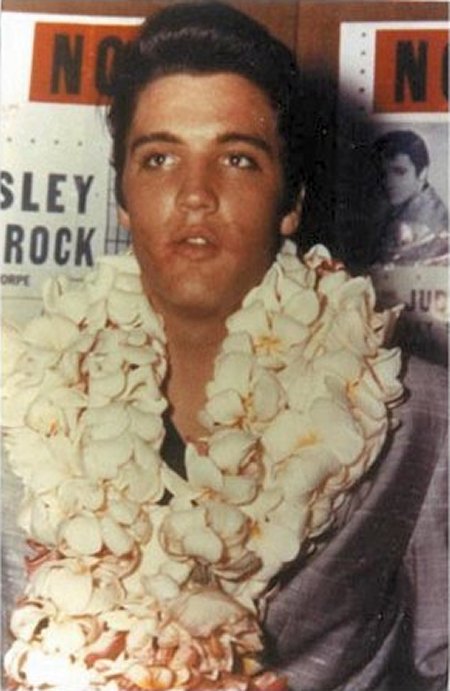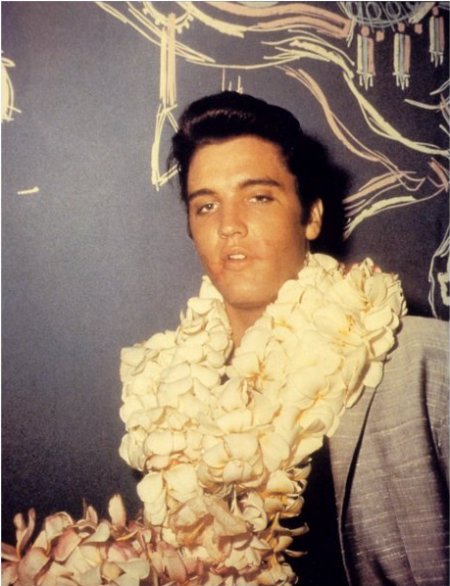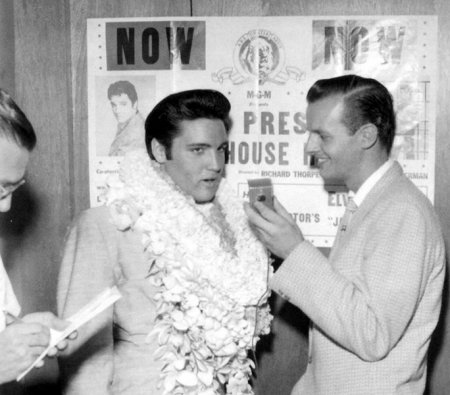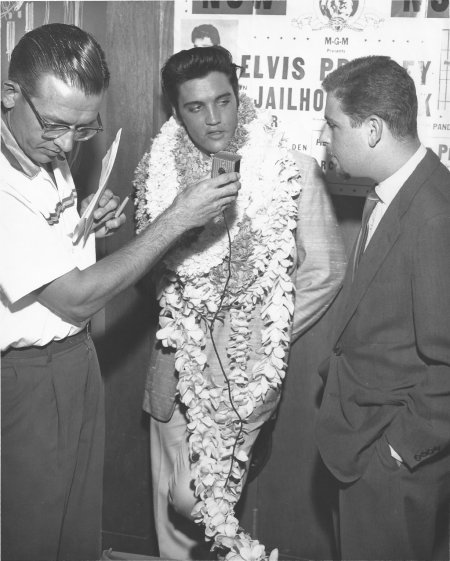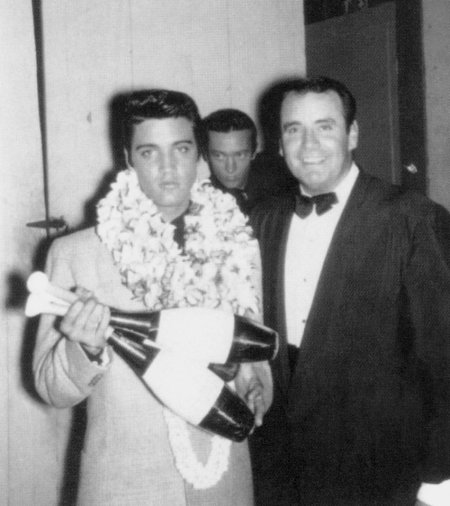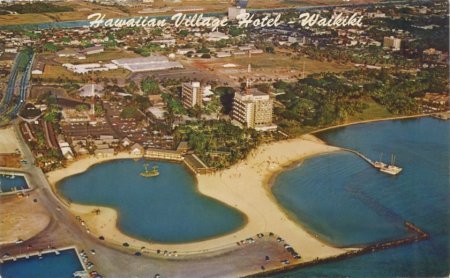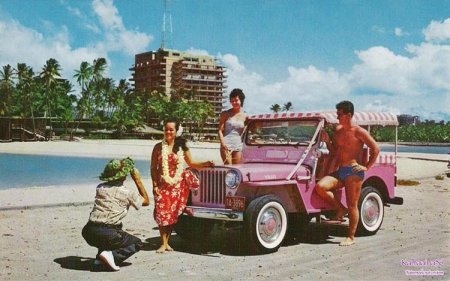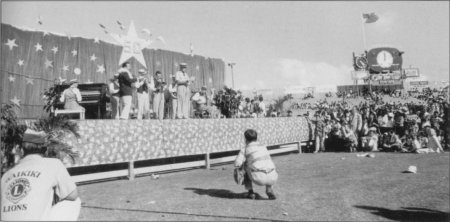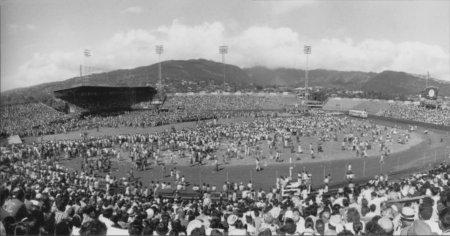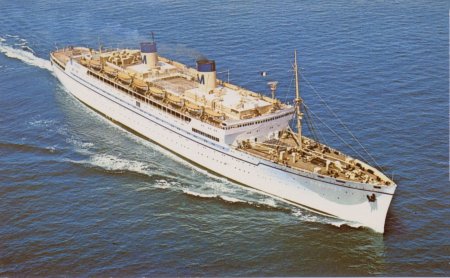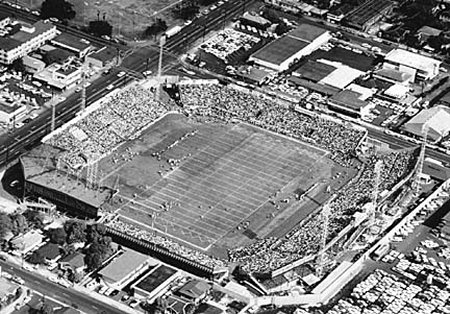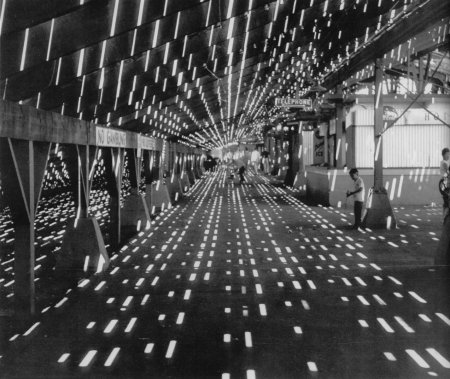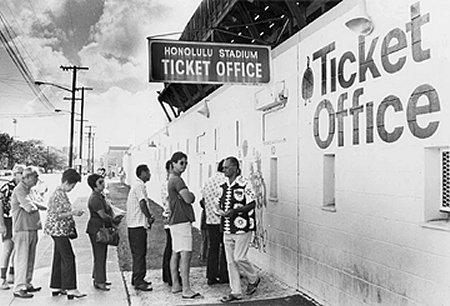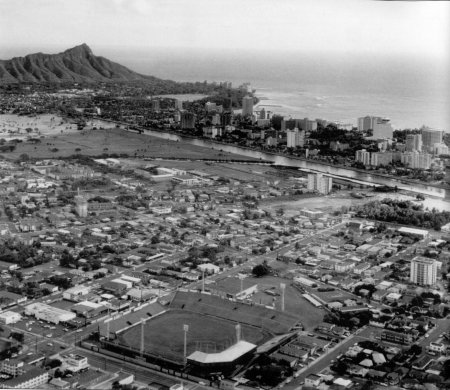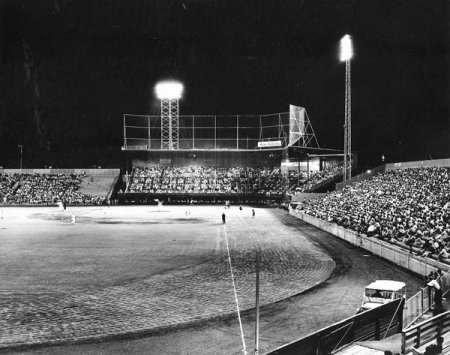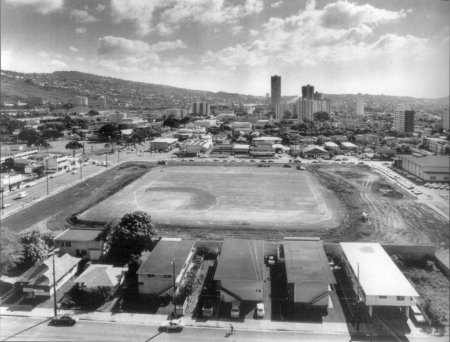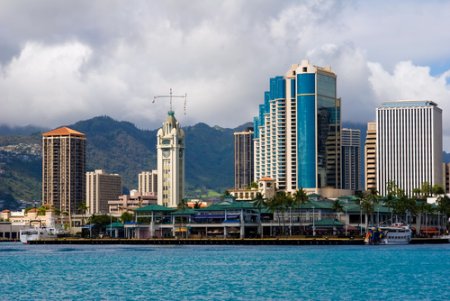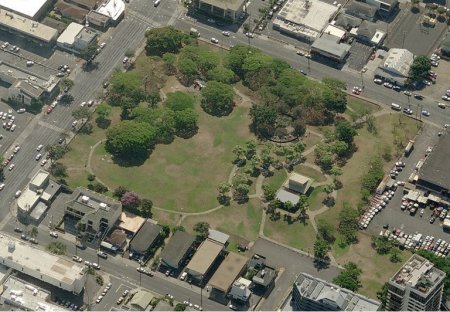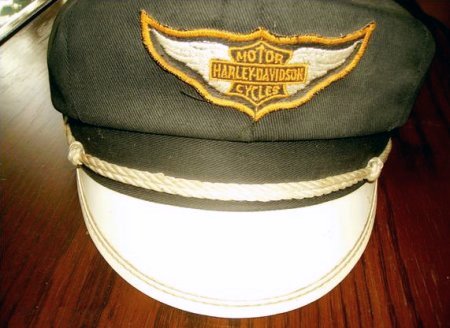 |
Honolulu Stadium
The city of Honolulu, the capital of Hawaii, is located on the southeastern shore of the island of Oahu. John Ashman Beaven, originally a newspaperman and lawyer from upstate New York relocated to Honolulu in 1910. In 1912, at the age of 43, he started the Oahu Baseball League and by 1917 leased land along King Street from the Honolulu Transit Company to build Moiliili Field as the new home for his League. Until then the heart of local sport had been the old Athletic Park near downtown Honolulu. Prior to the completion of the dredging of the Ala Wai Canal in 1927 by the Army Corp. of Engineers, much of the area and that of Waikiki in Honolulu were wetlands, swamps and rice paddies.1
Beaven's teams played at Moiliili Field for 8 years, as did the football league and many visiting teams from the mainland, Korea and Japan before becoming obsolete. In 1925 he borrowed $96,000 from industrialist William Castle to buy acreage located virtually across King Street from the Kaauila Land Trust and the following year founded Honolulu Stadium, Ltd. a corporation of Honolulu's prominent citizens in which he would be General Manager. With its startup funding the corporation bought a total of fourteen acres for $100,000 of which they sold five, and six were for the new field and bleacher area bordered by King, Isenberg and Banyan Streets and Makahiki Way. 1
In 1926 Oahu's population was less than 200,000, Wallace Farrington was mayor, some Japanese women walked the streets in kimonos and Oahu's tallest structure was Aloha Tower (built that year).2 Construction began in September of that year and concrete bases were sunk onto the coral below grade to support the steel framework for seating for 10,000. Temporary seating for 6,000 were set up in the end zones and a 10 foot high wood and barbed wire fence was built around the perimeter. Permanent bleachers along the mauka, ewa and Diamond Head borders wouldn't be completely in place until the end of World War II.1
Opening day was November 11, 1926, Armistice day, with an American Legion Benefit football game between the University of Hawaii and the Scotty Schumann's Town Team to decide the 1926 championship of the Senior Football league. The Town Team won 14 -7 before a crowd of 16,000, the largest to date to see a football game in Hawaii.1
In 1931 the Associated Students of the University of Hawaii negotiated a sublease to manage the Stadium during football season for a $10,000 a year rental fee. Babe Ruth played at the stadium in 1933 during an exhibition tour. By 1936 most of the share holders had donated their interests to the University and over the next three years smaller shares were purchased until ASUH and the University owned almost two thirds. They then were the ones to handle food and beverage concession rights, usage rights by baseball, football, polo and stock car racing. Beaven continued at the stadium until ill health prompted his retirement in 1939. He was succeeded by Ernest Tucker Chase, and then Theodore "Pump" Searle who was replaced by sports promoter Mackay Yanagisawa in 1956.1
When the permanent bleachers were finally added, the stadium held about 24,000 people but at times as many as 30,000 crammed inside. With just 87 parking space, including 11 for management and eight for the media, parking was obviously a problem. But the lack of parking created more of a community feeling, not less. People forced to walk for blocks through neighborhoods bought shaved ice, saimin or sweet bread from sidewalk vendors. Part of the event was finding a place to park, by paying someone to park in their lot or yard or parking at Central Union Church and taking the bus.2
In 1955, 108,000 tourists visited the islands, spending an estimated $56 million. That year three high-rise hotels opened in Waikiki and Henry Kaiser's Hawaiian Village opened its first 70 rooms.3 Henry J. Kaiser was one of the earliest and biggest boosters of the Hawaiian tourist industry. The Hawaiian Village Hotel complex was the territory’s first destination resort, extending over 22 acres of beach front in Waikiki.
He added its first tower, The Ocean Tower, at 14 floors in 1957. It was one of the worlds first theme hotels and it had a man made lagoon. They also rented "pink" catamarans to tourists. Kaiser also started his own radio station, KHVH, which stood for Kaiser Hawaiian Village Hotel and broadcast from rooftop studios in the hotel.
At the end October of 1957, Elvis, Scotty, Bill and D.J. had just completed a short tour of three cities in four days that included San Francisco, Oakland and Los Angeles. Like the tour just before that, it was promoted by Lee Gordon. Peter Guralnick in "Elvis Day by Day" wrote that booking agent and bandleader Al Dvorin recalled that this was intended to be the last show of the tour until Lee Gordon, who has been booking all of the biggest shows into Australia since the war and has been trying desperately to persuade the Colonel to let him book Elvis there, rolled dice with the Colonel for two Hawaiian dates. From Gordon’s point of view, this was like getting Elvis halfway to the goal, and the Colonel continues to talk with Gordon about booking Elvis in Australia until at least 1961, though how serious he is may be judged by the results.
Varying accounts have been given as to why the shows in Hawaii were added and the Colonel himself would later refute the dice story as a joke. Jailhouse Rock, Elvis' third film, opened nationally on November 8th and Elvis, when interviewed on his arrival said that the shows in Hawaii were added as a result of a delay in the start of his next movie. In Day by Day, Peter Guralnick suggested that it quite possibly was at least influenced by the fact that the Colonel himself had been stationed in Hawaii during his brief Army career between 1929 and 1932 and he took the opportunity to visit with old friends. An article in the Honolulu Star-Bulletin also gave this explanation:
On November 5th, Elvis sticking to his promise to his mother not to fly unless it was absolutely necessary, along with his entourage boarded the S.S. Matsonia in Los Angeles for the 4 day boat trip to Hawaii. His mother's, and likely his own, fears were no doubt reaffirmed by the fact that a Pan American flight en route to Hawaii from San Francisco with 44 people aboard had gone down in the ocean the night before his arrival. There was one small surprise at the dock: Billy Murphy showed up with his bags packed just as the ship was about to sail. Bill was a Hollywood regular and friends with John Wayne and Robert Mitchum. He had had several roles, including one in "Sands of Iwo Jima," and was well liked by Elvis and many of the guys. Elvis had invited him sometime earlier, but there had been no further discussion of the subject, and now a mild flurry of confusion arose before someone finally purchased a ticket for him. Other than that, the cruise was a dull one, made up of typical tourists and retirees and a notable absence of eligible girls.4
Cliff Gleaves, who continued to aspire to Hollywood hipness, followed Billy around to the point that Murphy finally told him, "Cliff you’re colorful and you’re interesting, but you’re ninety percent exaggeration and ten percent lies." Which kind of took the wind out of Cliff’s sails and gave the others something to chew on.4
Matson began passenger service to Honolulu in 1908, just two years before Beaman arrived in Honolulu. In 1931 Matson Lines commissioned the SS Monterey, built by Bethlehem Steel in Quincy, Massachusetts, at a cost of $8,300,492.00 with 472 first-class accommodations, 229 cabin-class and a crew of 360. In June 1932, the first cruise included San Francisco, Los Angeles, Honolulu, Auckland, Pago Pago, Suva, Sydney and Melbourne. In 1941 it was commissioned by the U.S. Marines and carried missionaries and U.S. citizens stranded in Asia, back home. It was used as a troop ship for the duration of WWII, and returned to civilian conversion in 1946. Sold to the government in 1952, it was re-fitted and re-purchased by Matson Lines in 1955 and christened the Matsonia by Mrs. Lucy Blaisdell. 5
To meet the increased demands of tourism to the islands, in June of 1957, it joined its sister ship, the Lurline (commissioned in 1932) in service between San Francisco, Los Angeles and Honolulu. With a length of 632 feet and a speed of 22 knots it was now completely air-conditioned. Spacious and distinctively designed public rooms and staterooms accommodated 761 passengers, all in first-class.
On the Matsonia, Elvis met Kailua resident Velma Fisher, whose husband, Luther, was a Matson chief engineer. Velma and her four children, Skip, Mona, Luana and Jana (ages eleven, nine, six and four) occupied a cabin three doors away from his and they met the first day when he and his entourage went to the daily bingo game. Velma handed out the game cards and introduced herself. She was forty three. "I didn't want to make a big fuss over him," Fisher remembers, "so I didn't ask for an autograph, but I did take pictures of him with the kids." 6
"He was always polite, a real gentleman," Fisher said, "and friendly. Ever day at cocktail time in the lounge, he played the piano for everybody and he was real easy to meet. My daughters took to him and I didn't mind leaving them in his care. He wasn't really a baby-sitter, but when I was away from the cabin, he looked in on them." Mona remembers sitting on the piano bench next to Elvis. "He started singing 'Love Me Tender,'" she said. "He told me he wrote that for me! I believed that one for years." 6
Another couple that became friendly with Elvis on the voyage were Jim and Marilyn Waste. My parents sailed to Honolulu, Hawaii in November, 1957 onboard the Matsonia. Much to their surprise Elvis Presley and his entourage were fellow passengers. Elvis caused quite a sensation by freely mixing with the other passengers. My parents knew who he was because they were young (28 and 27) and listened to Top 40 rock n’ roll radio stations. All the women on the ship were excited Elvis was onboard except for my Mom. She says that Elvis took it for granted that they all wanted to meet him and he flirted with them. But the fact was that my Dad was every bit as good-looking as Elvis, back in those days, if not more so, so my Mom failed to be smitten. She "wasn’t impressed." 7
Then one day she was on the deck reading the paperback version of Peyton Place and Elvis came up to her and offered her a red rose. He wanted to get to know her! Perhaps it’s because even though she was a mother of three (with the fourth on the way) my Mom was very beautiful back then. The students at San Mateo High School had voted her “Best Looking” and yet she was unspoiled by it all. Anyway, Elvis put his arm around my Mom and my Dad took some pictures. My Mom looks amused by it all in the pictures but you can tell she really wasn’t that excited. Later my Dad and Elvis did some trap-shooting together on the ship so they got to know each other a bit more. My parents said Elvis was a real gentleman and very polite.7
The end of my parent’s encounter with Elvis actually happened in their Waikiki hotel lobby. Suddenly there was a great commotion as Elvis arrived in the same hotel lobby, surrounded by his entourage and a large number of people. They said it was almost a mad mob scene, with reporters and fans whipped up into a frenzy. Elvis looked over and recognized my Dad and Mom and gave them a knowing shrug of the shoulders and expression on his face that meant, “Well, this is how it is for me, all of the time!” 7
The day before Elvis arrived, a telegram was sent from the ship to the Honolulu Star-Bulletin which they published in the paper. Lamar Fike, who among others accompanied Elvis on this trip also recalls the Colonel made at least one of the trips with them by ship, thinking it was the trip over but it had to have been on the way back. The Colonel actually flew to Hawaii the day before Elvis was scheduled to arrive to secure things and meet with the press.
For this trip, Elvis had reserved the entire 14th floor of the Ocean Tower at the Hawaiian Village Hotel and plans for security were detailed in the newspaper the week before.
Boat Day was a Hawaiian tradition of greeting arriving and departing passenger ships in a style that is island-indigenous and therefore unmistakably warm and welcoming. Ships had always been important to Hawaii. They brought provisions to the islands, as well as mail, materials, and people--and that included tourists, honeymooners, celebrities, and military personnel who were reporting to duty at the local Schofield Barracks. Pageant-like with color and crescendo, the scene back then was enhanced by the lush island melodies of the Royal Hawaiian Band, the excited scurrying of passengers to locate and claim luggage, and a profusion of animated friends and relatives poised pierside to proffer leis. Boat Day reached its pinnacle in the 1930s and continued as Matson liners, like the Lurline and the Monterey, brought passengers to Oahu.18 On Saturday, November 9th, the S. S. Matsonia arrived in Honolulu, on Boat Day.
"Back . . . back please. Presley is first—then the Congressmen," a harried Matson official muttered as he made way for Elvis Presley's debarkation this morning from the Matsonia at Pier 10. The rock 'n roll idol drew in his breath at the top of the gangplank, slicked back his long locks, planted a few moist kisses on nearby hula girls for the cameramen, and descended to the wild shrieks of some 4,000 fans. Brownie cameras clicked, girls, jostled and pressed forward, the while emitting a variety of Comanche yells. The teenagers weren't outfought but they were slickly outmaneuvered. 8
Colonel Torn Parker, Presley's manager, murmured a few quick comments to Elvis. Then the manager smoothly guided him to a waiting taxi and they disappeared in a matter of seconds, leaving the crowd milling uncertainly. Presley's fans may not get too close to the guitar-playing Tennessean, but they will see and hear him at two shows tomorrow. at 3 p.m. and 8 pm. in Honolulu Stadium. Elvis met the press (and two resolute lasses who managed to crash the function) aboard ship an hour before he landed.8
He wore a white knit sweater with a large rolled collar, a wine-colored sports coat flocked with black, black slacks, dark well-shined loafers and white socks checkered with brown. This 22-year-old with the build of an-Oklahoma halfback soon had skeptical newsmen singing his praises. Speaking with a Southern slur and liberally punctuating his answers with "suh," Elvis freely admitted, "I’m pretty green when it comes to clothes. "I don't pay over $7 for a shirt and $10 for a pair of shoes. But I do plan to stock up on a Hawaiian outfit while I'm here." 8
He said present plans call for his party of nine to return to Memphis, Tennessee, next week. Asked if he might visit any Neighbor Islands, he said. "It depends on how we're received here. Presley and Parker both indicated an Australian tour following their visit here is unlikely, although "We're always open to a last minute switch." He explained their sudden decision to visit the Islands this way: "It was a real rush deal. We were in Hollywood to make a picture (as yet unnamed), but it was postponed until the first of the year. We weren't doing anything, so Mr. Parker asked if we'd like to go to Hawaii. "I said, 'Huh!' and was packed right away." As for his traveling companions, mostly high school friends and disc jockeys, Presley said, "I like to have my friends along . . . it gives me a little touch of home. Anyway, it's more fun to see things together. "I've got a waiting list . . . pretty long one . . . of friends who want to make trips with me. "In fact I've heard from lots of so-called old friends from years ago who always say, ‘You remember me, don`t you?' " He said his latest hit, "Jailhouse Rock." has sold more than two million records in its first two weeks out. He didn't indicate whether this might be on his Hawaiian program, but he said enthusiastically that "Hawaiian music will certainly be on my program if I can learn any in time." 8
Other Presley views in a nutshell; Such nicknames as "Elvis the Pelvis"
are strictly juvenile. There was no confusion and no throngs of juveniles when Presley and his party arrived at the Hawaiian Village Hotel. Several teen-age girls were waiting quietly, and one of them-Babette (Bobby) Andre-presented the singer with a lei and the kiss that goes with it. Presley returned the kiss vigorously. Miss Andre walked away in a happy daze. The Jordanaires and Presley's guitar, bass and drums accompanists are scheduled to arrive by plane at 4:30 this afternoon.8 Scotty, Bill, DJ, and the Jordanaires took a United Airlines flight. This time they would break tradition and stay in the same hotel with Elvis, who had reserved the entire fourteenth floor of the Hawaiian Village Hotel. Scotty's $12-a-night room was plusher than he usually got on the road.9 In spite of the security, it didn't sway all fans from going to the hotel. Elvis threw cut up scraps of clothing and records down to them. Naturally, not all of the records would survive the drop from the 14th floor intact.
The Honolulu Star-Bulletin announced the line-up and format for Sunday's shows, albeit on Monday, the day after.
For the Hawaiian shows, it was obviously cost prohibitive to bring the acts that they had been touring with on most of their stateside performances during the last year and a half. This time they supplemented the show with local acts. The anchor band for most of the acts at the Stadium shows was the Ray Tanaka Orchestra. Ray Norito Tanaka, a Honolulu native, had been performing since the forties and over the years would head different bands. The other acts were regulars at the Queen's Surf.
In the 1950's and 1960's the Queen's Surf restaurant and bar, at 2709 Kalakaua Avenue, overlooking the beach in front of Kapiolani Park was Waikiki's most popular nightspot. It was built in 1949 in the former beach home of multimillionaire Chris Holmes, heir to the Fleischmann's Yeast fortune, by Spencer and Clifton Weaver, sons of famed architect Fullerton Weaver who had designed the Waldorf-Astoria in New York. The Tahitian Revue at the Surf, specialty luau and South Pacific presentations gave it at times an atmosphere of at three-ring circus. The Barefoot Bar was upstairs where the footprints of the most prominent locals in the travel industry were placed on the wall along with their names. It was said to be always packed with local and Hollywood celebrities and you had to know someone to get in.11
Sterling Edwin Kilohana Mossman, was a detective with the Honolulu Police Department by day, and the central character of the Barefoot Bar by night.Nicknamed "The Hula Cop," Mossman combined impressive singing talent with hilarious comedy and novelty songs, and surrounded himself with a sterling group of talented Waikiki entertainers.12 Mossman paved the way for what would be called the "modern" style of Don Ho, who started his career at his mother’s bar, Honey’s in Kaneohe, and began to sit in at the Barefoot Bar when Mossman took breaks.11
The Eddie
Spencer Band included bassist Joe Marshall and singer/guitarist Gabby Pahinui (click
Tom Moffat and Ron Jacobs were two of the deejays hired by Kaiser at KHVH radio broadcasting from the studio on top of the hotel. Ron said, fellow deejay Tom Moffatt and I pulled a prank that became "The First Elvis Impersonator." They had the station's engineer dress up like Elvis with a black wig and ride around town in a convertible making frequent stops to phone in their location to the station and then driving away quickly when fans approached. However, Tom and Ron's prank created enough of a stir to attract the attention of the Colonel. Fortunately Elvis and Colonel dug it. We each emceed concerts at Honolulu Stadium. Ron emceed the matinee show while Tom emceed the evening. Ron said, a lifelong friendship began with Parker, who became a mentor. On his many Hawaii trips, Colonel arranged exclusive Elvis promotions for us.14
Walt Christie of the Honolulu Star Bulletin reviewed the shows the following day. Those frenetic fans who "loved" Elvis Presley before seeing him in person yesterday are even more ardent today. And those who werent "sent" before still aren't. About 15,000 Honolulans spent $32,000 yesterday to see for themselves just what sort of entertainer sparks the Presley cult. Response, it must be chronicled, was maxed. On the plus side of the ledger is the fact that the hula-hipped, crazy-legged Elvis is a versatile singer.15
He's America's top money entertainer and, more significantly, tradesters predict he'll be around for several years to come. Once his fanatical folIlowing abates, Presley can emerge as a mighty competent "straight" singer. On the negative side is the fact that Americas two-legged answer to the Sputnik violates every rule in the book when it comes to showmanship. Right now—obviously—that doesn't matter. lt there ever were a "pre·sold" attraction, Elvis is it. He could do no wrong as far as last nights shrieking, beat-clapping enthusiasts were concerned.15
He scratched his ear--and squeals of joy echoed through the uninhabited audience that jam-packed the makai side of Honolulu Stadium. He shrugged a shoulder of his sparkling metallic-threaded jacket—and the girls literally bounced up and down in their seats. The king can do no wrong. And Elvis, make no mistake, IS the king of the teen-agers who—the same teenagers who snap up each of his recordings by the millions and who sacrifice lunch money so they can buy a ticket to see him. Elvis, it appears, enjoys this mass hero worship. Indeed there are times when you wonder how he can keep a straight face as he watches his audience.15
Presley had ’em rockin' if not always rollin' to the tempos of many of his best-known songs. Matter of fact, he was on stage for about 40 minutes, accompanied by his own trio and the Jordanaires quartet. Surprisingly, he spent more time at the piano than he did with his guitar. His routine is paced effectively, gradually mounting in tempo to a climax that sees him jumping offstage and toward the front rows of the audience, then making a hasty retreat to a waiting auto.15
The audience's mass emotion wasn't dampened in the least by two flurries of rain, a whirl of dust, the poor lighting of the on-field stage, and mediocre public-address facilities. It would be a mistake to generalize about audience reaction. The king is all things to all people. It's not only teenagers who were "oohing" and bouncing and shrieking to his beat and loose-legged gyrations. Many of the teenagers' mothers were, too. And a 7-or-8-year-old girl sitting near this writer was equally responsive.15
The male audience, for the most part, was far more reserved or, at least, stoic. In some eases, it was bored. That, in the long run, may be Presley's biggest handicap. Right now, without going into social significance or sex appeal or personal magnetism, he‘s strictly for the girls. If you’re still wondering about his bewildering effects upon the bewildered parents and their bewildering offspring, you can see him in action tonight at Schofield Barracks. Of one thing you can be sure. It‘ll be the most memorable thing that’s happened at Schofield since December 7, 1941.15
In an almost unrelated incident, Walt included in his review the odd snippet:
MOTHER LAUGHS OFF STABBING AFTER ELVIS SHOW
Bob Kraus reviewed the Stadium shows the following day in The Honolulu
Advertiser.
Elvis Presley left Honolulu teenagers all shock up yesterday after two rock 'n roll concerts at Honolulu stadium.
Thousands of kids nearly went out of their minds screaming at the loose-jointed antics of their singing idol as he wiggled and wobbled
and clowned his way through an hour-long performance.
Primed by an opening half program of Juggling, hula sword dancing and jive, the teenage audience (mostly girls) set up a shrill, continuous scream an Elvis romped on the open air stage dressed in a gold lame jacket trimmed in silver, a black shirt, black slacks and black loafers. He stood still for a moment, then threw an experimental wobble at his fans. As if he had pushed a button, the audience erupted with screams. From then on the concert resembled some kind of primitive religious ceremony with the audience gradually working itself into a greater and greater frenzy.16
One girl behind me kept screaming with shrill intensity of hysteria. Between screams she gasp, "Oh, Elvis, you're killing me. I can’t stand it, I can't stand it." It is difficult to judge Presley's performance as a singer on the basis of yesterday afternoon’s concert. The screams drowned out his voice a great portion of the time. This apparently didn't bother his teenage fans, who seemed to recognize each melody from the opening word. "Don't Be Cruel" and "Hound Dog" drew the maximum decibels of admiration.16
Ooddly enough, there was very little clapping after each number. But Presley had only to say, "thank you very much." and the audience would scream. He'd scratch his nose; another scream. He'd laugh; another scream. At times, the singer seemed to deliberately push the button by dropping his arm or wiggling his shoulder, just to hear his fans react. Then he'd laugh, it seemed to me, partly at himself and partly at the audience.16
FOR ALL of his inept clowning on the stage, the singer is obviously an expert at teasing the greatest possible hysteria from his teenage worshippers. The best example was his closing number. "You Ain't Nothin' But a Hound Dog," which brought the audience to its feet from the opening note. Presley threw his hips around. wobbled his knees, flopped his shoulders and shook all over until the girls in the stands were hopping up and down with excitement.16
Then, for the first time, he sat down on the edge of the stage. Teenagers began pressing forward to see better and the police (I counted 30 inside the stadium) nervously closed ranks. Finally, he hopped dawn upon the grass in front of the stage. The crowd nearly went crazy. Girls climbed up to stand on the sides of the box I was sitting in. Others were standing precariously on chairs.
Meanwhile. Presley was rolling on the grass moaning out the words of "Hound Dog." He kissed a girl across the barricade set up to keep the audience away from the stage, grabbed a coconut hat and paraded with it on his head.16
WAVE AFTER WAVE OF screams rolled across; the stadium as he finished the song. Then, he turned, stepped into a waiting car and sped out of sight before most of the excited teenagers knew he was gone. Often criticized for lewdness in connection with his hip swinging gyrations, Presley, in my opinion, was not objectionable at the stadium. He was loose but he wasn't lewd. Tonight, Presley will give a final show at Schofield Barracks.16
In between Sunday's performances at the stadium, Elvis returned to the Hawaiian Village Hotel for a press conference.
Elvis was 15 minutes late for his press conference at the Hawaiian Village, which gave me time to chat with a young lady who had arrived an hour early to assure herself of a front row seat. "I'm Barbara Wong, president of the Kaneohe Elvis Presley Fan Club," said the pony-tailed teen-ager, adjusting a 63 foot lei and a pair of binoculars. She was wearing a pink dress appliquéd with profiles of Elvis in black. "Pink and black, his favorite colors" she sighed. "I made it myself when 'Love Me Tender' came out. I've written him a letter every week for two years. He answered one. I haven't had a wink of sleep for four days." She turned a pair of glazed eyes on me in proof of her sleepless devotion.
Just what do you see in Elvis? I asked.
With that, the livin' man strode into the room and the president of the Kaneohe Elvis Presley Fan Club threw herself on him like a meringue pie. The members of the press shifted uneasily as Elvis, powerless as Laocoon in the coils of Miss Wong and her 63-foot lei, attempted to extricate himself. Finally he lifted her bodily and carried her to her front row seat.17
"Is it true you're asking $100,000 for a TV appearance?"
"WHATS YOUR REACTION TO those older people who don't like you?" This was
from Miss Wong again.
"That's enough." broke in Elvis's manager. "Will the radio people now
come forward to record their questions."
Following the press conference, Elvis penned a short note to Antoinette Mendonca, age nine. She had been a patient at the Mahluhia Hospital since an operation the previous August to relieve pressure from a brain tumor. For the first time in months, Antoinette grinned and she tried to talk after seeing the note that read, in part, "Please get well, honey. I'll be thinking of you."10
The two concerts at the Honolulu Stadium attracted nearly 15,000 fans, bringing in more than $32,000 to the promoters. The next day they performed for 10,000 civilians and military personnel from Schofield Barracks Army Base near Pearl Harbor. Scotty was happy to be back onstage again with Elvis and company, but with Elvis facing the draft, questions about their future lingered.9
In 1958 Kaiser added the second of several more towers to the Hawaiian Village hotel complex. Starting in 1959 they also rented pink Jeep surreys to tourists, not surprising since Kaiser Industries owned Willys-Overland, the company that made the jeeps. (Do they look familiar?) Ron Jacobs said, Pink was Kaiser's color. Everything was pink, from his many Mercedes to the stationary and paycheck. In 1961 Kaiser sold the Hawaiian Village Hotel to Hilton. The original Ocean Tower was renovated in 1982 to become the present day Alii Tower.
In
March of 1959, Congress passed legislation allowing Hawaii Statehood and
on August 21st of that year President Eisenhower officially declared
Hawaii the 50th
State in the Union. More than 25,000 filled the field and
bleachers in Honolulu Stadium in celebration. The photos with the stage
should give some perspective of the view of fans sitting in the
bleachers for Elvis' shows.
By the early 1960s air travel was becoming more reliable and popular and as tourism increased, passenger service by ship decreased. The Matsonia was put in dry dock in 1962 but brought back to service when its sister ship, the S.S. Lurline, was damaged in 1963. Re-christened Lurline by Mrs. Harry Statts, December 6, 1963, it cruised the Pacific Ocean under this name from 1963 until 1970.5
At the peak of its popularity, the Queen’s Surf became the subject of a feud between the Weavers and Mayor Frank Fast. Fast, a powerful and opinionated mayor, was never fully attuned to tourism. He also had personal differences with Weaver and decided that the “Surf' should be eliminated and the property converted into beachfront for the public. 19 It was shut down on December 31, 1969 and nearly 700 people tried to crowd into to the club to say goodbye. The mayor's decision was appealed and then upheld by the Hawaii State Supreme Court, which terminated the nightclub's lease as of May 31, 1970. The building was torn down in 1971.20
Honolulu Stadium would also sport professional football, with the Hawaiian Warriors, and minor league professional baseball with the Hawaiian Islanders for more than 10 years.21 In its day it also saw prizefights, rodeos, spiritual crusades and hula festivals and the list of professional athletes and other celebrities that appeared or competed there include Irving Berlin, Billy Graham, Knute Rockne, Jesse Owens, Joe DiMaggio and Bobo Olson.
Plagued by termites, the wooden Honolulu Stadium was nicknamed the Termite Palace by the sports media. In 1975, the 50,000 seat Aloha Stadium was built west of downtown Honolulu in Halawa, as a replacement for Honolulu Stadium and the following year, in 1976, Honolulu Stadium was demolished. Just before it was demolished, insect researchers were given permission to conduct termite lab experiments there.21
In May 1970, the SS Matsonia was sold and became the
successful Chandris passenger liner RHMS Britanis, then sold again in
1998, to become the ill-fated Belofin. On
October 21, 2000 while being towed to be broken up, the ship took on
water and sunk about 50 miles off
Today, 177,756 visitors are in the State of Hawaii on an average day, spending more than $11 billion a year.3 The site of the old Honolulu Stadium is now a park.
page added August 31, 2009 All articles and ads are courtesy Linda Sueyoshi of the Hawaii & Pacific Section and the Hawaii State Library. Honolulu Advertiser ads and articles are Copyright © the Honolulu Advertiser, Honolulu Star-Bulletin articles are Copyright © the Star-Bulletin. Special thanks to Ron Jacobs and to Russell Letson for their input with this page. 1 according to "Honolulu Stadium: Where Hawaii Played" by Arthur Suehiro
|
||
|
All photos on this site (that we didn't borrow) unless otherwise indicated are the property of either Scotty Moore or James V. Roy and unauthorized use or reproduction is prohibited. |


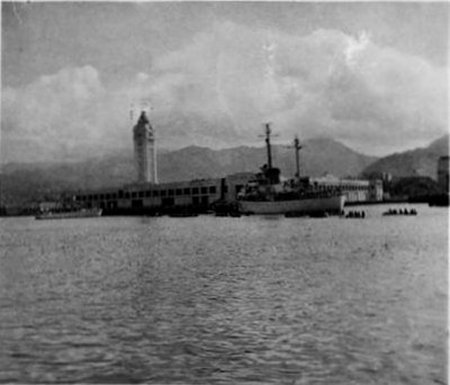

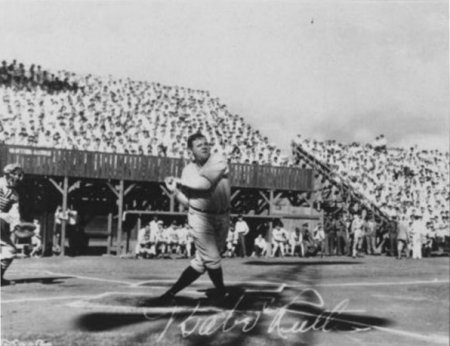
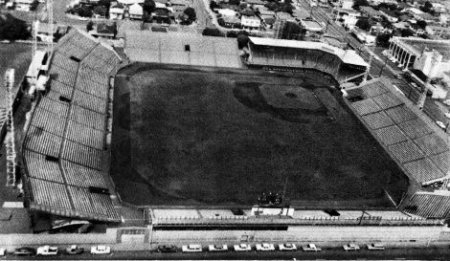
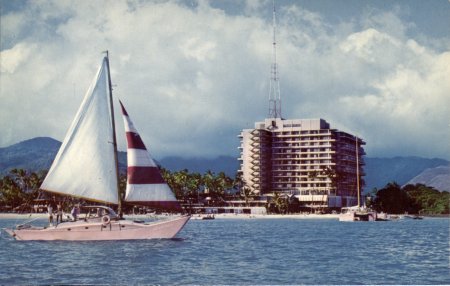
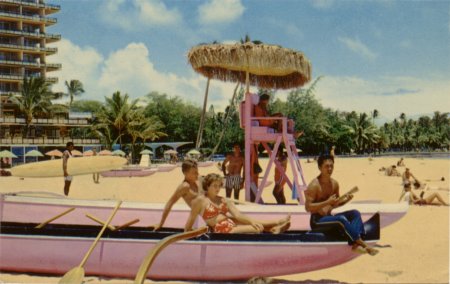
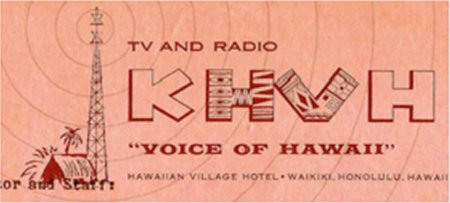
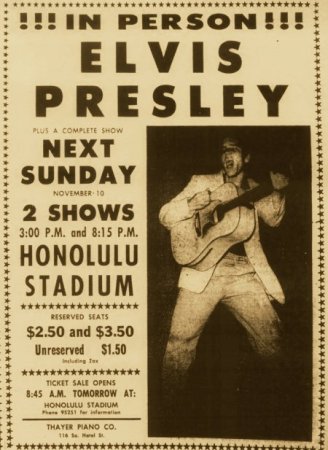
 21,000 Isle Christmas Cards in '56
21,000 Isle Christmas Cards in '56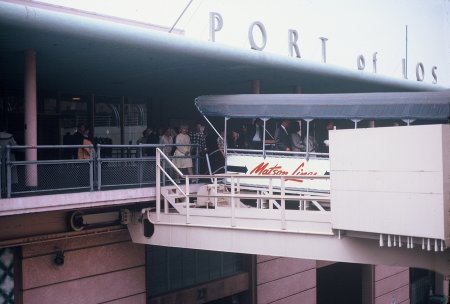
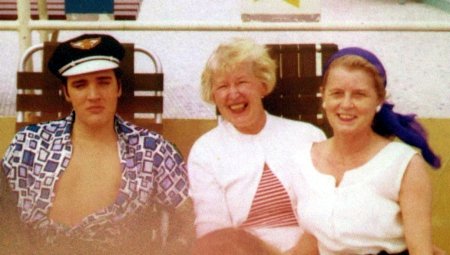
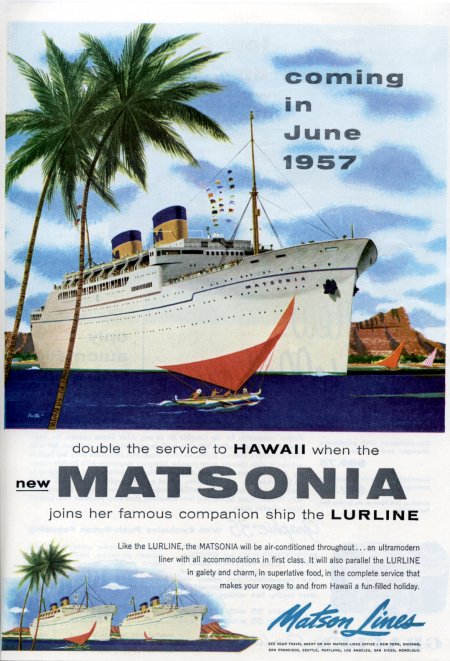
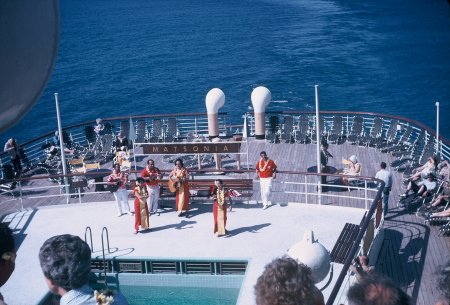
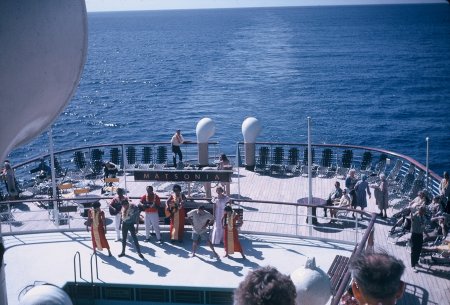
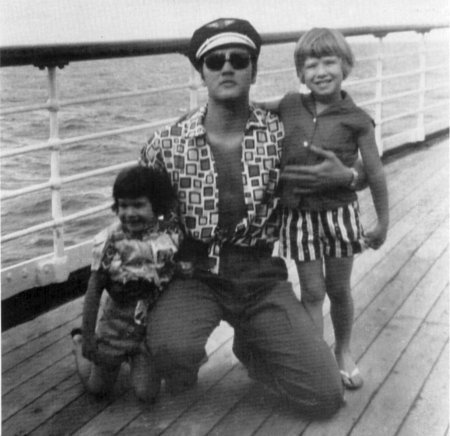
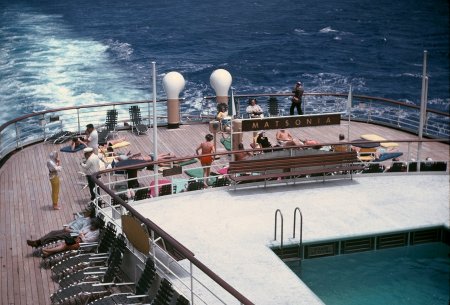
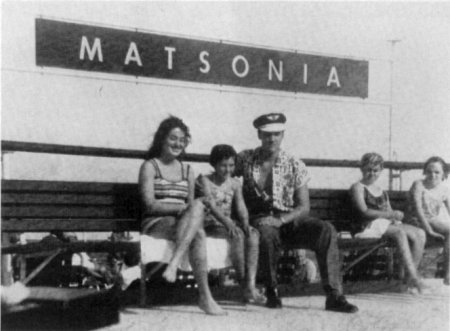
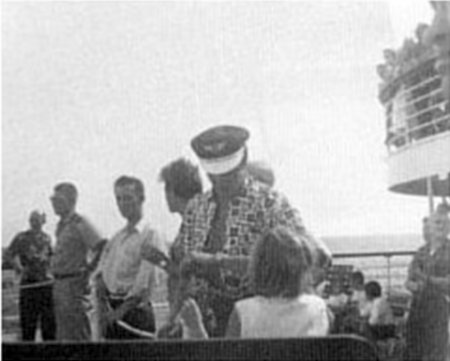
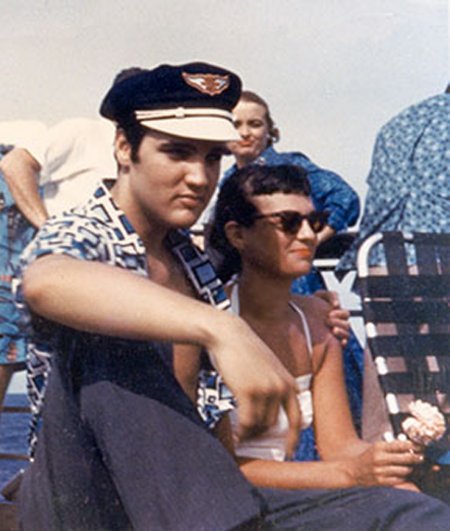
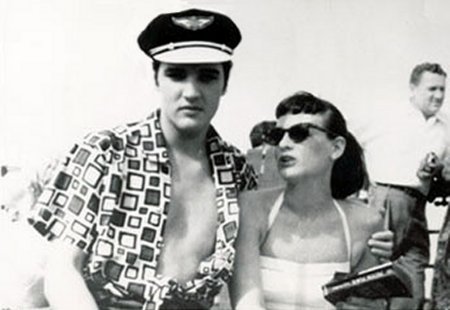
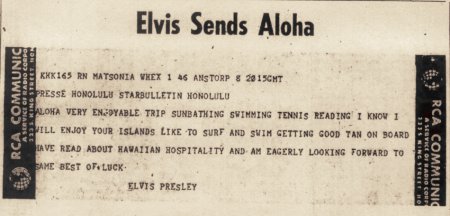

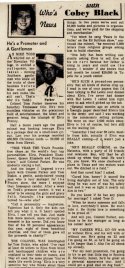 He's a Promoter and a Gentleman
He's a Promoter and a Gentleman
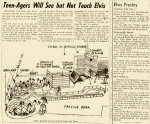 Teen-agers
Will See but Not Touch Elvis
Teen-agers
Will See but Not Touch Elvis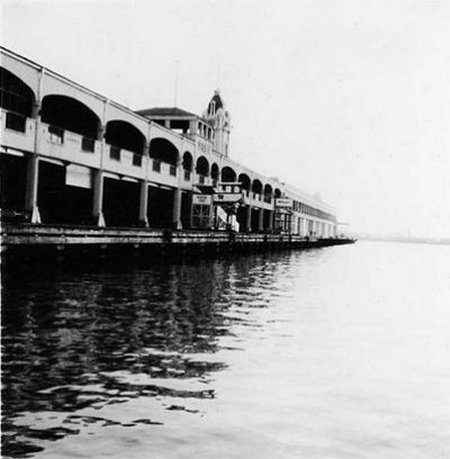
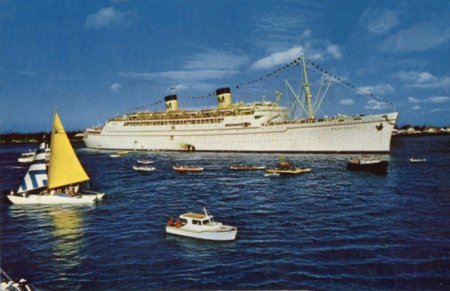
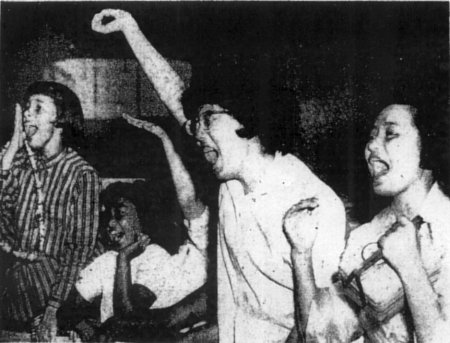
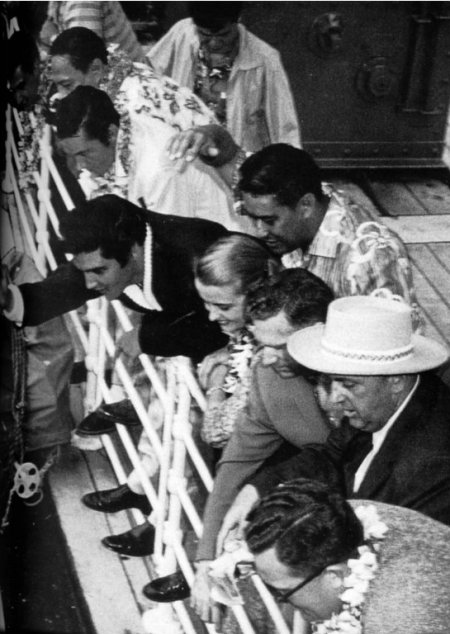
 Flying
Wedge Defeats Admirers
Flying
Wedge Defeats Admirers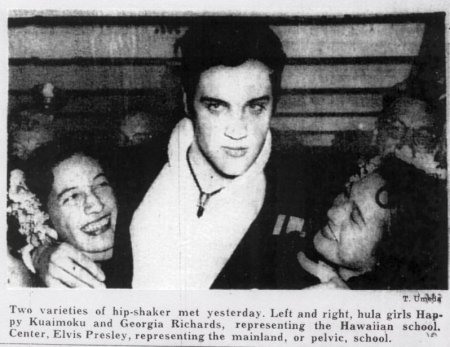
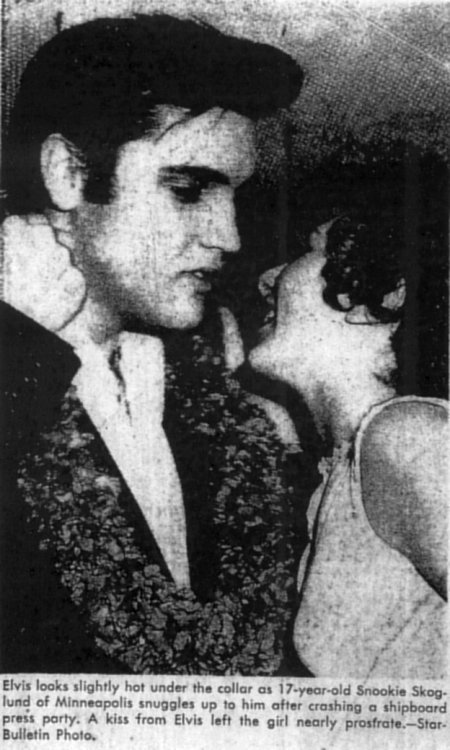
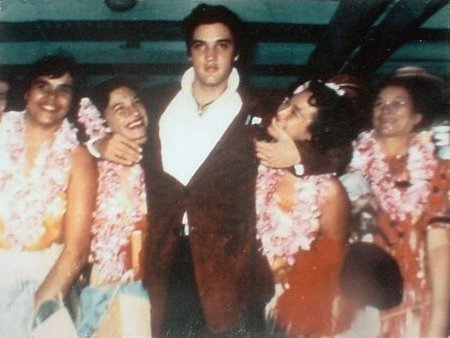
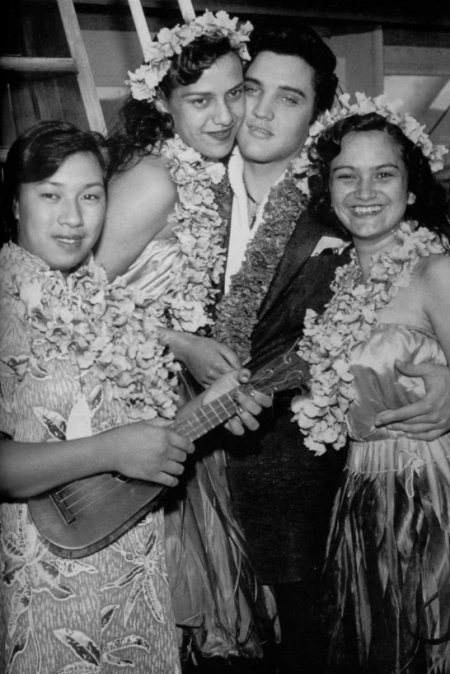
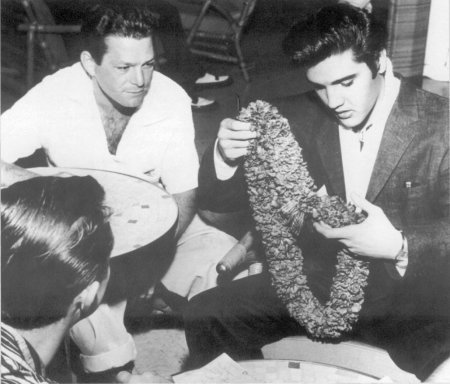
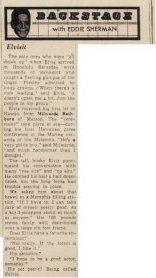 BACKSTAGE
with EDDIE SHERMAN
BACKSTAGE
with EDDIE SHERMAN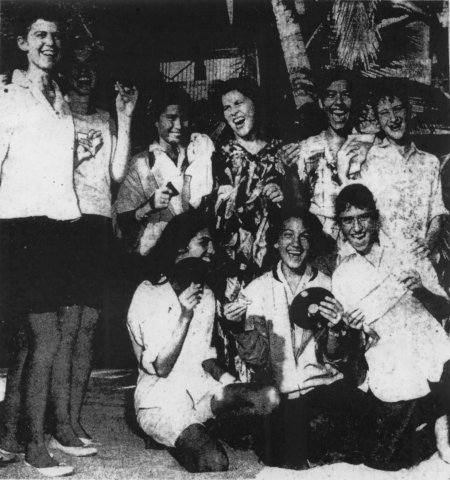
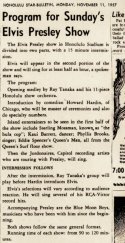 Program for Sunday's Elvis Presley Show
Program for Sunday's Elvis Presley Show
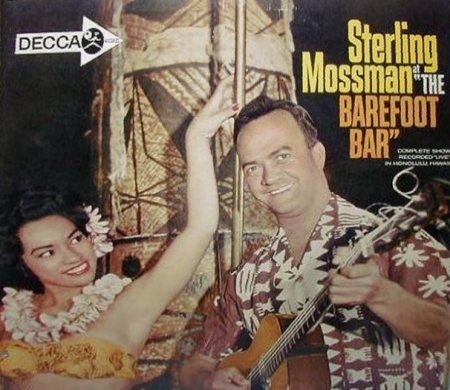
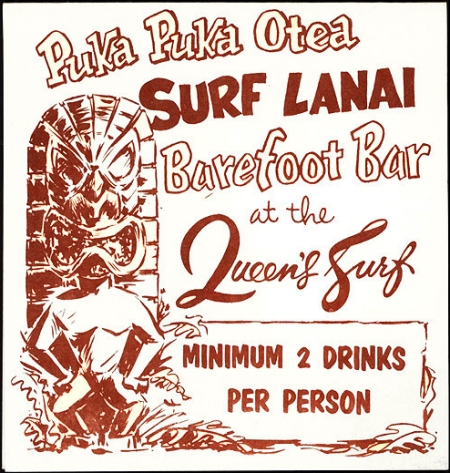
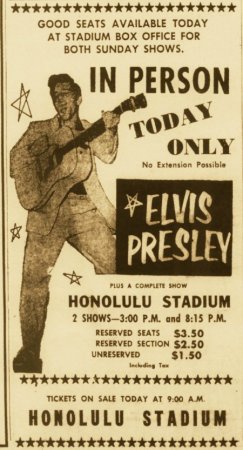

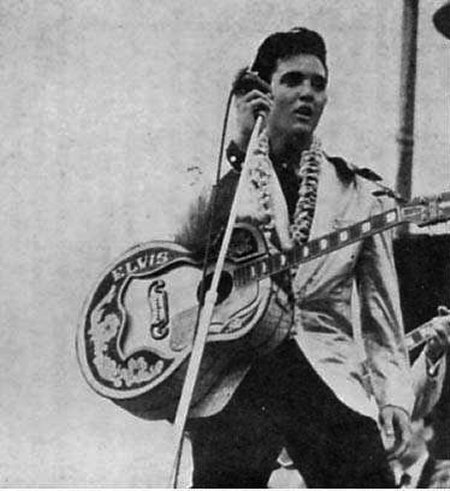
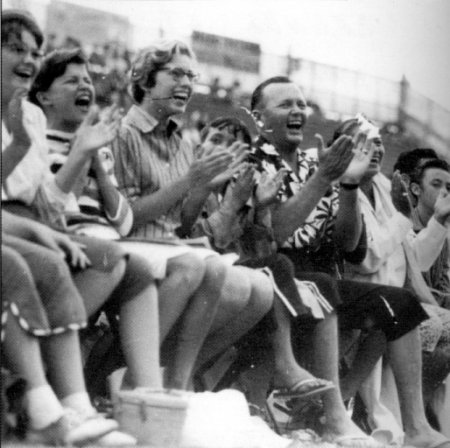
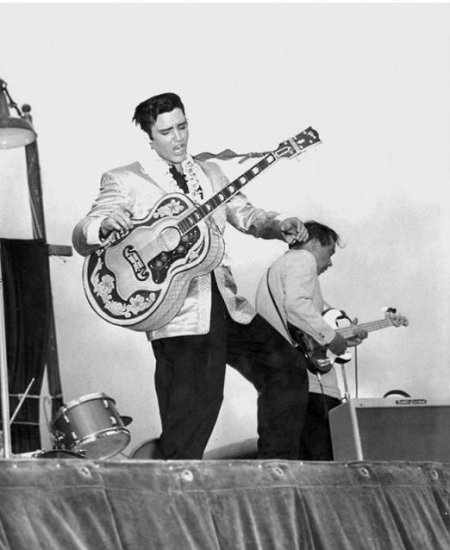
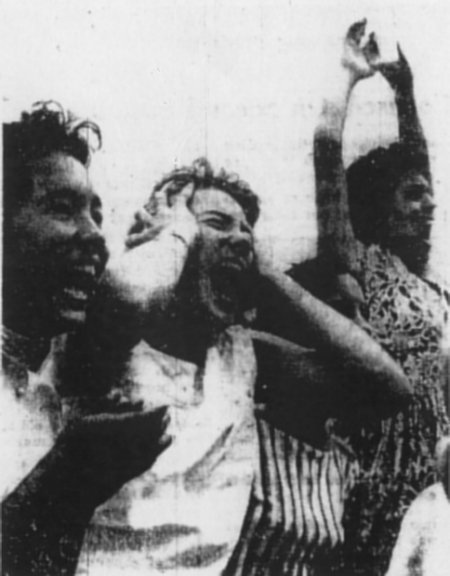
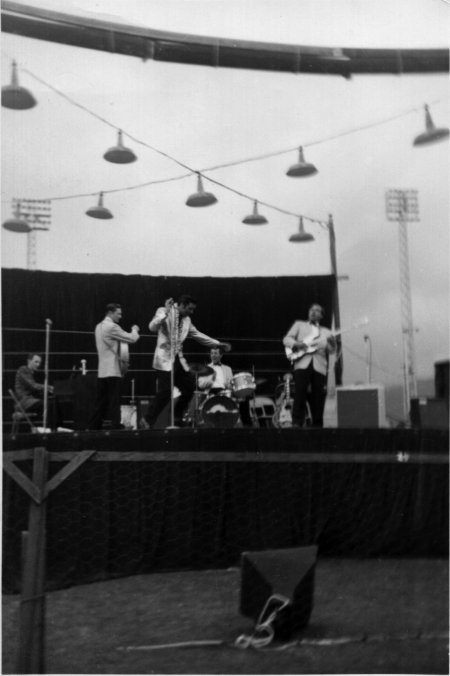
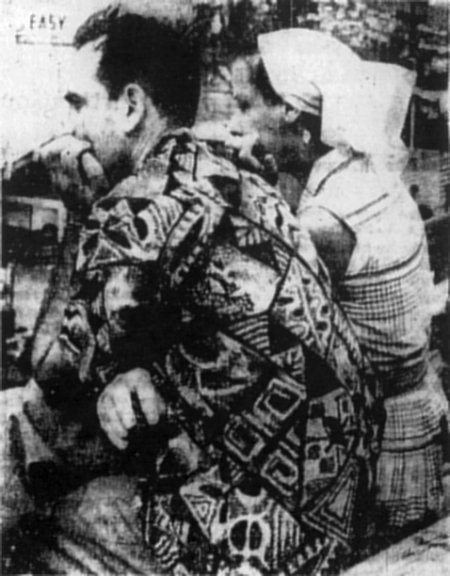
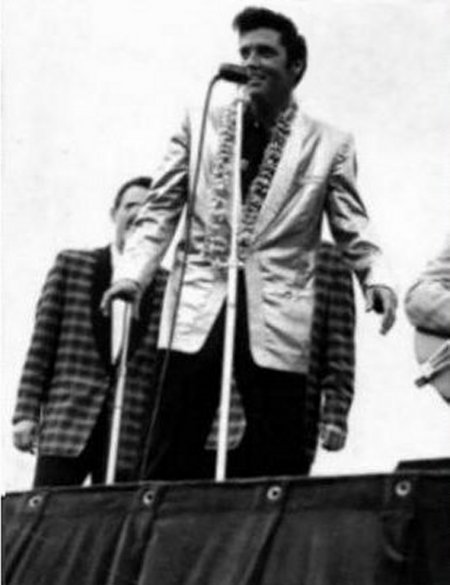
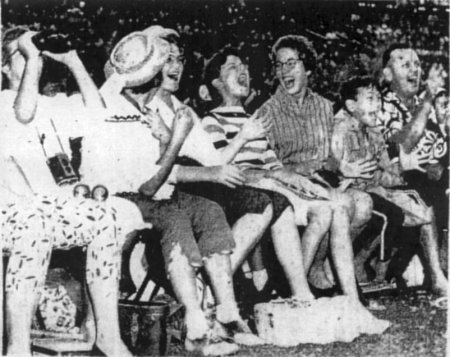
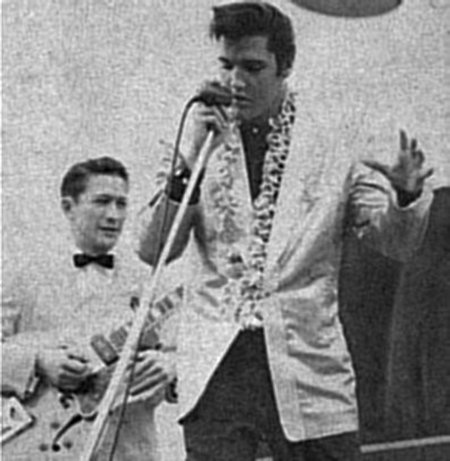
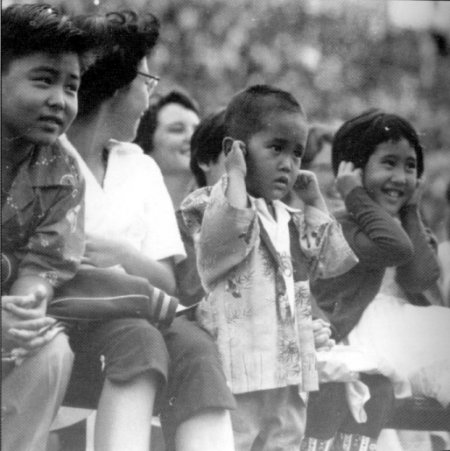

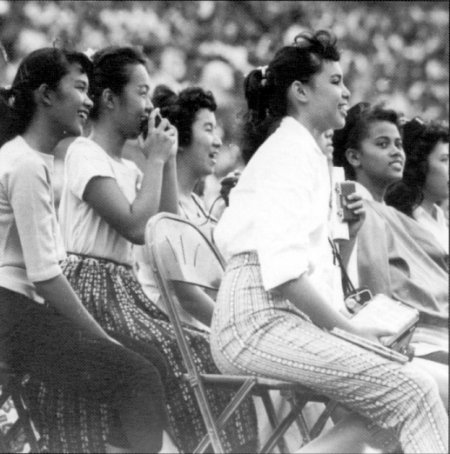

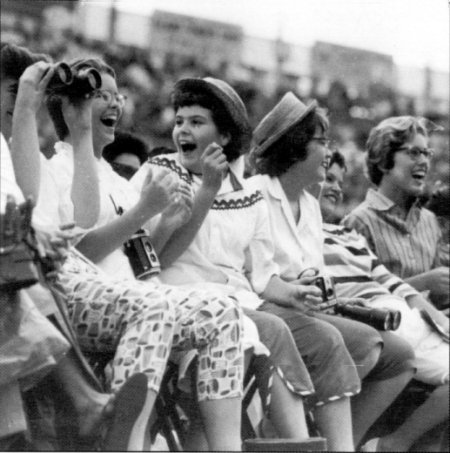
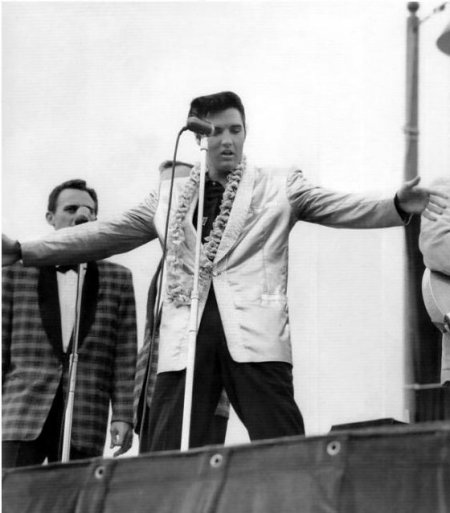

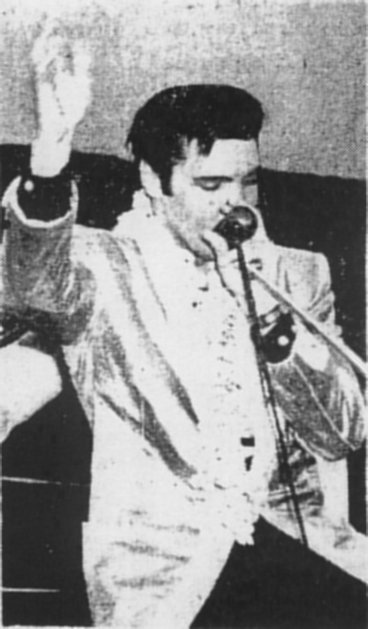
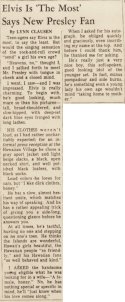 Elvis Is 'The Most"
Elvis Is 'The Most"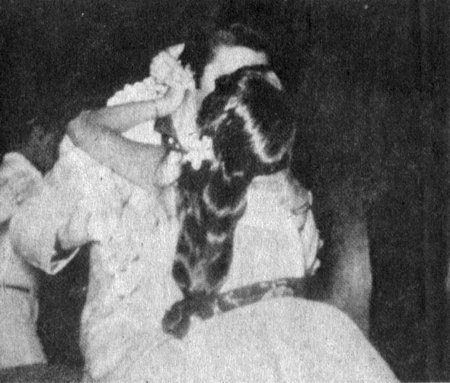
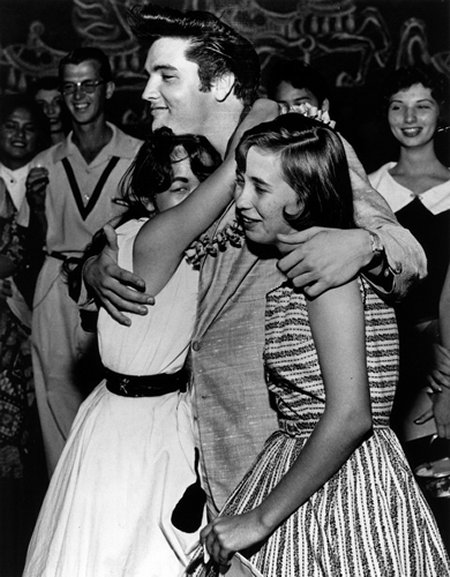
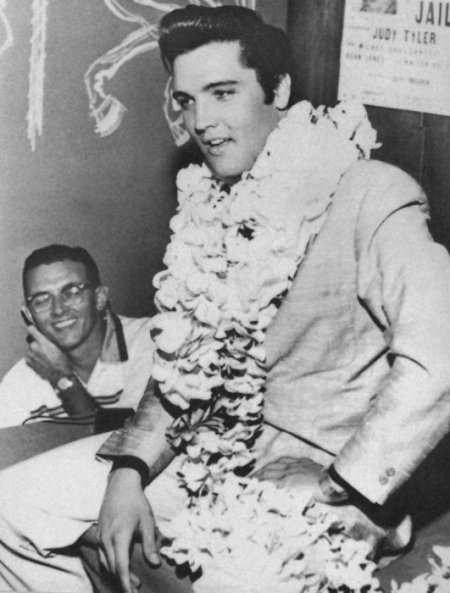
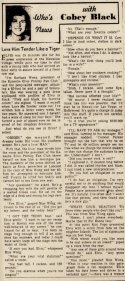 "Any questions?", he asked. He's strapping boy with the soft profile of
a melted Greek coin. He sat on the edge of a desk and swung his legs
restlessly.
"Any questions?", he asked. He's strapping boy with the soft profile of
a melted Greek coin. He sat on the edge of a desk and swung his legs
restlessly.